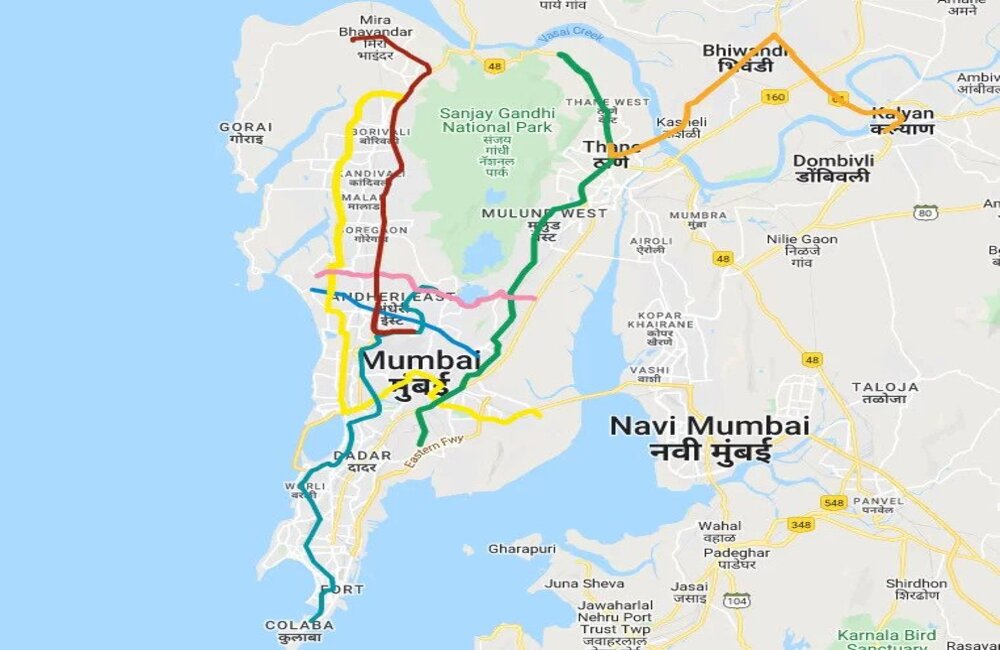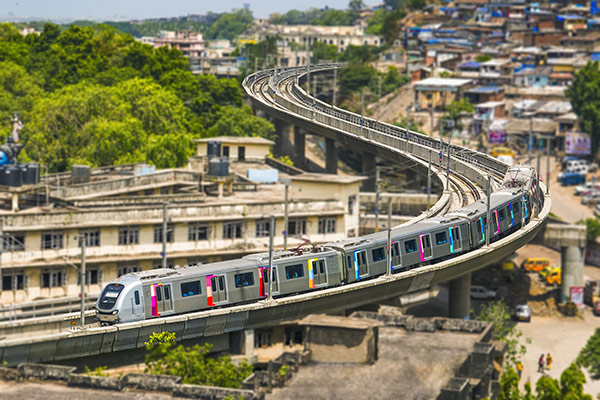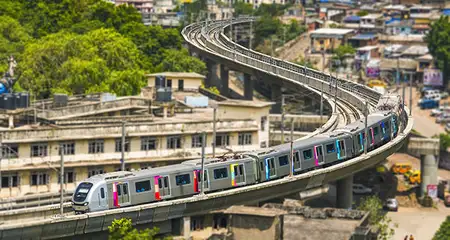Mumbai Metro, which serves the city of Mumbai, is a mass rapid transit system. It is being built in three phases in a bid to decongest the Mumbai suburban railway. Eventually, the metro network is envisioned to have 14 lines across some 337 km route length. The system is mostly being built underground or on elevated viaducts, with a tiny portion at grade. The trains, which run at a top speed of 80 km/h, carry just over 5,50,000 people every day. Standard-gauge (1,435 mm) tracks and 25 kV Alternating Current (AC) via overhead catenary are used on the system.
Mumbai Metro Quick Info
- Owner: Mumbai Metropolitan Region Development Authority (MMRDA)
- Serving Cities: Mumbai
- Number of Lines and Stations (operational): 3 lines and 43 Stations
- Headquarters: Bandra–Kurla Complex
- Started Operations in 2014
- Daily Timings: 5:20 am to 11:46 pm
Mumbai Metro Route Map

Mumbai Metro Line Map
Mumbai Metro History
In June 2006, Prime Minister Manmohan Singh laid the foundation stone for the first phase of the Mumbai Metro project. However, the construction work began in February 2008. A successful trial run was conducted in May 2013. The Mumbai Metro began its operations on June 8, 2014, with the inauguration of Line 1, also known as the Versova-Andheri-Ghatkopar (VAG) corridor.
The initiative to develop the Mumbai Metro was undertaken by the Mumbai Metropolitan Region Development Authority (MMRDA), which is responsible for the planning and implementation of various infrastructure projects in the Mumbai Metropolitan Region.
Line 1 of the Mumbai Metro is operated by Mumbai Metro One Private Limited (MMOPL), a joint venture between Reliance Infrastructure (69%), Mumbai Metropolitan Region Development Authority, (26%) and RATP Dev Transdev Asia, France (5%).
In June 2019, a new nodal agency called Maha Mumbai Metro Operations Corporation (MMMOCL) was established for operating and maintaining all Mumbai Metro services on lines owned by MMRDA.
Mumbai Metro Lines
All the metro lines are in various stages of construction. Some are also categorised under the proposed segment. Travellers looking to commute on these metro lines can easily access hotels in Mumbai near Versova, Andheri and Ghatkopar.
Operational Lines
- Line 1 Blue Line- (Versova-Andheri-Ghatkopar corridor): This was the first line to be operational and spans approximately 11.4 kilometers with 12 stations, connecting the eastern and western suburbs of Mumbai.
- Line 2A Yellow Line- (Dahisar-Andheri West): This line is operational with 17 stations covering a distance of 18.6 km.
- Line 7 Red Line- (Gundavali to Dahisar East corridor): This line is operational with 14 stations covering a distance of 16.5 km.
Under Construction and Proposed Lines
- Line 3 Aqua line-(Colaba-Bandra-SEEPZ corridor): Also known as the Mumbai Metro Rail Project (MMRP), Line 3 is currently under construction. It will connect Colaba in South Mumbai to SEEPZ in the northwestern suburbs. Line 3 is expected to be a fully underground corridor and is anticipated to significantly improve connectivity in the city.
- Line 2B Yellow line- (DN Nagar-Mandale corridor): This line will connect DN Nagar to Mandale and will be around 23.6 kilometers long. It is expected to provide connectivity to various key locations in Mumbai, including the Mumbai International Airport.
- Line 4 Green line-(Wadala-Kasarvadavali corridor): Line 4 will span approximately 32.3 kilometers, connecting Wadala in central Mumbai to Kasarvadavali in Thane. This line will cater to the growing residential and commercial areas of Thane.
- Line 5 Orange Line-(Thane to Kalyan): It will connect Thane to Kalyan with a distance covering 23.50 km and 17 stations.
- Line 6 Pink line- (Swami Samarth Nagar-Jogeshwari-Kanjurmarg-Vikhroli corridor): Line 6 will run from Swami Samarth Nagar in Lokhandwala to Vikhroli and is expected to improve connectivity in the eastern suburbs of Mumbai.
- Line 9 Red line- (Dahisar East to Mira Bhayandar): Line 9 will connect Dahisar East to Mira Bhayandar and is expected to provide improved connectivity to the northern suburbs.
- Line 8 Gold Line-Chhatrapati Shivaji Maharaj International Airport (CSIA) to Navi Mumbai International Airport (NMIA): This line will connect the airports covering 35 km with 7 stations.
The table below summarises the Mumbai Metro Lines.
| Metro Line | Route | Total Length (in km) | Number of Stations | Status |
| Blue Line (Line 1) | Versova – Andheri – Ghatkopar | 10.8 | 12 | Operational |
| Yellow Line (Line 2A) | Dahisar East – D.N. Nagar | 18.6 | 17 | Partially Operational |
| Yellow Line (Line 2B) | D.N. Nagar – Mandale | 23.6 | 22 | Under construction |
| Aqua Line (Line 3) | Cuff Parade – Bandra Kurla Complex – Seepz – Aarey Colony | 33.5 | 27 | Under construction |
| Green Line (Line 4) | Wadala – Kasarawadavali | 32.3 | 32 | Under construction |
| Green Line (Line 4A) | Kasarawadavali – Gaimukh | 2.8 | 2 | Under construction |
| Orange Line (Line 5) | Thane – Bhiwandi – Kalyan | 24.9 | 17 | Under construction |
| Pink Line (Line 6) | Swami Samarth Nagar – Vikhroli | 15.1 | 13 | Under construction |
| Red Line (Line 7) | Dahisar East – Andheri East | 16.5 | 14 | Partially Operational |
| Red Line (Line 7A) | Andheri East – CSI Airport | 3.1 | 2 | Under construction |
| Gold Line (Line 8) | CSI Airport – NMIA | 35 | 7 | Proposed Stage |
| Red Line (Line 9) | Dahisar East – Mira Bhayander | 11.3 | 8 | Under construction |
| Green Line (Line 10) | Gaimukh – Shivaji Chowk on Mira Road | 9.2 | 4 | Approved |
| Green Line (Line 11) | Wadala – Chhattrapati Shivaji Maharaj Terminus | 12.7 | 10 | Proposed Stage |
| Orange Line (Line 12) | Kalian – Taloja | 20.7 | 17 | Proposed Stage |
| Purple Line (Line 13) | Shivaji Chowk in Mira Road – Virar | 23 | 20 | Proposed Stage |
| Magenta Line (Line 14) | Kanjurmarg – Badlapur | 45 | 40 | Proposed Stage |
Mumbai Metro Line 1 – Blue Line
Line 1, also known as the Versova–Andheri–Ghatkopar Line, is the only line currently operational of Mumbai Metro. It runs in an east–west direction through central Mumbai for 10.8 km via 12 stations. The line uses 1,435 mm (Standard gauge) tracks and overhead catenary carrying AC at 25 kilovolts. Though the line has a maximum permissible speed of 80 km/h, the four-coach trains run at 65 km/h. The headway between the trains varies from 3 minutes during peak hours to 5 minutes at other times of the day.
Stations on Line 1
| Station | Interchange/Connections | Nearby Accommodation |
| Versova | Hotels near Versova | |
| DN Nagar | ||
| Azad Nagar | ||
| Andheri | Andheri Railway Station | Hotels in Andheri |
| Western Express Highway | ||
| Chakala (JB Nagar) | Hotels near Chakala | |
| Airport Road | ||
| Marol Naka | Chhatrapati Shivaji International Airport Terminal 2 | |
| Saki Naka | Hotels in Saki Naka | |
| Asalpha | ||
| Jagruti Nagar | ||
| Ghatkopar | Ghatkopar Railway Station | Hotels near Ghatkopar |
Mumbai Metro Yellow Line 2A & 2B – Yellow Line The list below is of the stations covered on the Mumbai Metro Line 2A.
| Station Name | Interchange/ Connections | Nearby Accommodation |
| Dahisar East | Line 7A- Red Line | Hotels near Dahisar |
| Upper Dahisar Station (Anand Nagar) | ||
| Kandarpada (Rushi Sankul) | ||
| Mandapeshwar (IC Colony) | ||
| Eksar | ||
| Borivali West (Don Bosco) | Hotels near Borivali West | |
| Pahadi Eksar (Shimpoli) | ||
| Kandivali West (Mahavir Nagar) | Hotels in Kandivali | |
| Dahanukarwadi (Kamraj Nagar) | ||
| Valnai (Charkop) | ||
| Malad West | Hotels in Malad | |
| Lower Malad (Kasturi Park) | ||
| Pahadi Goregaon (Bangur Nagar) | Hotels in Goregaon | |
| Goregaon West | ||
| Oshiwara (Adarsh Nagar) | Line 6- Pink Line | |
| Lower Oshiwara (Shastri Nagar) | ||
| Andheri West (D.N. Nagar) | Line 1- Blue Line | Hotels in Andheri West |
*Note: The stations from Valnai to Andheri West are under construction. These stations will become fully operational by next year (2024). The list below is of the stations covered on the Mumbai Metro Line 2B.
| Station Name |
| ESIC Nagar |
| Prem Nagar |
| Indira Nagar |
| Nanavati Hospital |
| Khira Nagar |
| Saraswat Nagar |
| National College |
| Bandra Metro |
| ITO BKC |
| IL&FC, BKC |
| MTNL, BKC |
| SG Barve Marg |
| Kurla East |
| Eastern ExpressHighway |
| Chembur |
| Diamond Garden |
| Shivaji Chowk |
| BSNL |
| Mankhurd |
| Mandala |
Mumbai Metro Line 3 – Aqua Line
| Station Name |
| Cuff Parade |
| Badhwar Park |
| Vidhan Bhawan |
| Churchgate |
| Hutatma Chowk |
| CST Station |
| Kalbadevi |
| Girgaon |
| Grant Road |
| Mumbai Central |
| Mahalaxmi |
| Science Museum |
| Acharya Atrey Chowk |
| Worli |
| Siddhivinayak Temple |
| Dadar |
| Shitladevi Temple |
| Dharavi |
| Income Tax Office BKC |
| Vidyanagri |
| Santa Cruz |
| Mumbai Domestic Airport |
| Sahar Road |
| Mumbai International Airport |
| Marol Naka |
| MIDC |
| SEEPZ |
| Aarey Colony |
Mumbai Metro Line 4 – Green Line
| Station Name |
| Shivaji Chowk |
| Gaimukh |
| Kasarawadavali |
| Vijay Garden |
| Dongripada |
| Tikuji-ni-Wadi |
| Manpada |
| Kapurbawdi |
| Majiwada |
| Cadbury Junction |
| Mahapalika Marg |
| RTO Thane |
| Teen Hath Naka |
| Mulund Naka |
| Mulund Fire Station |
| Sonapur |
| Shangrila |
| Bhandup |
| Bhandup Nagarpalika |
| Naval Housing |
| Gandhi Nagar |
| Surya Nagar |
| Vikhroli |
| Godrej Company |
| Shreyas Cinema |
| Laxmi Nagar |
| Pant Nagar |
| Garodia Nagar |
| Siddharth Colony |
| Anik Nagar Bus Depot |
| Wadala Truck Terminus |
| Bhakti Park |
Mumbai Metro Line 5 – Orange Line
| Station Name |
| Kalyan APMC |
| Kalyan Station |
| Sahajanand Chowk |
| Durgadi Fort |
| Kon Gaon |
| Gove Gaon MIDC |
| Rajnouli Village |
| Temghar |
| Gopal Nagar |
| Bhiwandi |
| Dhamankar Naka |
| Anjur Phata |
| Purna |
| Kalher |
| Kasheli |
| Balkumbh Naka |
Mumbai Metro Line 6 – Pink Line
The list below is of the stations covered on the Mumbai Metro Line 6.
| Station Name |
| Swami Samarth Nagar |
| Adarsh Nagar |
| Momin Nagar |
| JVLR |
| Shyam Nagar |
| Mahakali Caves |
| SEEPZ Village |
| Saki Vihar Road |
| Ram Baug |
| Powai Lake |
| IIT Powai |
| Kanjurmarg |
| Vikhroli (EEH) |
Mumbai Metro Line 7 – Red Line
The list below is of the stations covered on the Mumbai Metro Line 7.
| Station Name | Interchange/ Connections | Nearby Accommodation |
| Dahisar East | Yellow Line | |
| Ovaripada | ||
| National Park | ||
| Devipada | ||
| Magathane | Indian Railways, Central Line, Harbour Line | |
| Poisar | ||
| Akurli | ||
| Kurar | Western Line | |
| Dindoshi | Indian Railways, Western Line | |
| Aarey | ||
| Goregaon East | Pink Line | Hotels in Goregaon East |
| Jogeshwari E | ||
| Shankarwadi | ||
| Gundavali | Line 7A- Red Line |
*Note: The stations from Goregaon East to Gundavali are under construction. These stations will become fully operational by next year (2024).
Mumbai Metro Line 9 – Red Line
The list below is of the stations covered on the Mumbai Metro Line 9.
| Station Name |
| Pandurang Wadi |
| Miragaon |
| Kashigaon |
| Sai Baba Nagar |
| Meditya Nagar |
| Shaheed Bhagat Singh Garden |
| Subhash Chandra Bose Ground |
*Note: Mumbai metro lines 8, 10, 11, 12, 13, and 14 are under the proposed phase.
Mumbai Metro Lesser-Known Facts
- Only metro in India where different lines have different owners
- Fastest in India to cross a total ridership of 250 million (957 days)
- Initial maximum permissible speed fixed at 50 km/h; raised over time to 80 km/h
- All trains have a black box for help in investigations in case of accidents
Navi Mumbai Metro
Navi Mumbai Metro is an urban Mass Rapid Transit System (MRTS) with 1 line being built to serve the area of Navi Mumbai (Belapur, Kharghar, Taloja & more) in Maharashtra by City and Industrial Development Corporation (CIDCO). The City and Industrial Development Corporation (CIDCO) received the CMRS certificate on June 21, 2023, for the commercial operation of the Navi Mumbai Metro Line.
Phase 1 will connect CBD Belapur to the Pendhar Metro station with a distance covering 11.1 km with 11 stations.
FAQs
Q. When was Mumbai Metro started?
A. The Mumbai Metro began its operations on June 8, 2014, with the inauguration of Line 1, also known as the Versova-Andheri-Ghatkopar (VAG) corridor.
Q. Which is the largest metro in Mumbai?
A. Yellow line of the Mumbai Metro is considered to be the longest stretch at 18.60 km with 17 stations.
Q. Which is the 2nd largest metro in Mumbai?
A. In Mumbai Metro, the Red Line (Line 7) is the second longest operational line with a distance covering 16.5 km with 14 stations.
Q. Who made the metro in Mumbai?
A. The initiative to develop the Mumbai Metro was undertaken by the Mumbai Metropolitan Region Development Authority (MMRDA), which is responsible for the planning and implementation of various infrastructure projects in the Mumbai Metropolitan Region.
Q. Which is the 2nd largest metro in India?
A. Bangalore metro is the current second largest metro network in India with the distance covering approx 75 km after the Delhi Metro which is covering approx 391 km of distance.
Q. Which is the cleanest metro in Mumbai?
A. The Mumbai Metro has made significant efforts to maintain cleanliness by implementing regular cleaning schedules, and waste management systems, and educating passengers about maintaining cleanliness inside the trains and stations.
Q. Which metro line is the longest in Mumbai?
A. Yellow line of the Mumbai Metro is considered to be the longest stretch at 18.60 km with 17 stations.
Q. Which is the fastest metro in Mumbai?
A. All the operational lines of Mumbai Metro runs on an average speed of 80km/hr makes it one the fastest commuting option in Mumbai.








